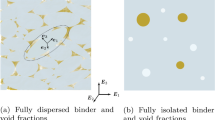Abstract
The thermomechanical response of HMX/Estane, a polymer-bonded explosive (PBX) is analyzed for initial temperatures between 210 and 300 K. The main objective of this analysis is to gain a better understanding of the concepts that lead to deformation and heating of energetic composites as they undergo mechanical and thermal processes subsequent to impact. A recently developed cohesive finite element method (CFEM) framework is used to study the microstructure-level response of PBX. The CFEM framework allows the contributions of individual constituents, fracture and frictional contact along failed crack surfaces to heating to be tracked and analyzed. Digitized micrographs of actual PBX materials are used. The issues studied include large deformation, thermomechanical coupling, failure in the forms of microcracks in both bulk constituents and along grain/matrix interfaces, and frictional heating. The focus is on the correlation between grain-level failure mechanisms and overall temperature rise in the PBX. The results are used to establish microstructure-response relations that can be used in the design of energetic composites.
Similar content being viewed by others
References
Benson DJ, Conley P (1999) Eulerian finite-element simulations of experimentally acquired HMX microstructures. Model Simul Mater Sci Eng 7: 333–354
Tarver CM, Chidester SK, Nichols AL (1996) Critical conditions for impact- and shock-induced hot spots in solid explosives. J Phys Chem 100: 5794–5799
Tarver CM, Tran TD (2004) Thermal decomposition models for HMX-based plastic bonded explosives. Combust Flame 137: 50–62
Gray GT III, Bluementhal WR, Idar DJ, Cady CM (1998) Influence of temperature on the high strain-rate mechanical behavior of PBX 9501. Schmidt SC, Dandekar DP, Forbes JW (eds) Shock compression of condensed matter, 1997, AIP press, Woodbury, pp 583–586
Govier RK, Gray GT, Blumenthal WR (2008) Comparison of the influence of temperature on the high-strain-rate mechanical responses of PBX 9501 and EDC37, pp 535–538
Blumenthal WR, Gray GT, Idar DJ, Holmes MD, Scott PD, Cady CM, Cannon DD (2000) Influence of temperature and strain rate on the mechanical behavior of PBX 9502 and Kel-F 800TM. AIP Conf Proc 505: 671
Tan H, Liu C, Huang Y, Geubelle PH (2005) The cohesive law for the particle/matrix interfaces in high explosives. J Mech Phys Solids 53: 1892–1917
Baer MR (2002) Modeling heterogeneous energetic materials at the mesoscale. Thermochim Acta 384: 351–367
Trott WM, Baer MR, Castaneda JN, Chhabildas LC, Asay JR (2007) Investigation of the mesoscopic scale response of low-density pressings of granular sugar under impact. J Appl Phys 101(2): 024917
Menikoff R (2003) Pore collapse and hot spots in HMX. Presented at the APS Topical Conference, Portland
Idar DJ, Straight JW, Osborn MA, Skidmore CB, Phillips DS, Buntain GA (2000) PBX 9501 high explosive violent reaction: phase II baseline and aged experiments. See http://www.fas.org/sgp/othergov/doe/lanl/lib-www/la-pubs/00538217.pdf.
Ortiz M, Pandolfi A (1999) Finite-deformation irreversible cohesive elements for three-dimensional crack-propagation analysis. Int J Numer Methods Eng 44: 1267–1282
Banerjee B, Cady CM, Adams DO (2003) Micromechanics simulations of glass-estane mock polymer bonded explosives. Model Simul Mater Sci Eng 11: 457–475
Wu Y-Q, Huang F-L (2009) A micromechanical model for predicting combined damage of particles and interface debonding in PBX explosives. Mech Mater 41: 27–47
Barua A, Zhou M (2011) A Lagrangian framework for analyzing microstructural level response of polymer-bonded explosives. Model Simul Mater Sci Eng 19: 24
Barua A, Horie Y, Zhou M (2012) Energy localization in HMX-Estane polymer-bonded explosives during impact loading. J Appl Phys 111: 11
Barua A, Horie Y, Zhou M (2012) Microstructural level response of HMX-Estane polymer-bonded explosive under effects of transient stress waves. Proc Royal Soc 468: 3725–3744
Barua A, Kim S, Horie Y, Zhou M (2012) Ignition criterion for heterogeneous energetic materials based on hotspot size-temperature threshold. J Appl Phys, (Under Peer Review)
Zhai J, Zhou M (2000) Finite element analysis of micromechanical failure modes in a heterogeneous ceramic material system. Int J Fract 101: 161–180
Siviour CR, Laity PR, Proud WG, Field JE, Porter D, Church PD, Gould P, Huntingdon-Thresher W (2008) High strain rate properties of a polymer-bonded sugar: their dependence on applied and internal constraints. Proc Royal Soc Math Phys Eng Sci 464: 1229–1255
Zhai J, Tomar V, Zhou M (2004) Micromechanical simulation of dynamic fracture using the cohesive finite element method. J Eng Mater Technol Trans ASME 126: 179–191
Tomar V, Zhai J, Zhou M (2004) Bounds for element size in a variable stiffness cohesive finite element model. Int J Numer Methods Eng 61: 1894–1920
Tvergaard V, Hutchinson JW (1992) The relation between crack-growth resistance and fracture process parameters in elastic plastic solids. J Mech Phys Solids 40: 1377–1397
Camacho GT, Ortiz M (1996) Computational modelling of impact damage in brittle materials. Int J Solids Struct 33: 2899–2938
Cady CM, Blumenthal WR, Gray GT, Idar DJ (2006) Mechanical properties of plastic-bonded explosive binder materials as a function of strain-rate and temperature. Polym Eng Sci 46: 812–819
Rae PJ, Goldrein HT, Palmer SJP, Field JE, Lewis AL (2002) Quasi-static studies of the deformation and failure of beta-HMX based polymer bonded explosives. Proc Royal Soc Lond Ser A 458: 743–762
Menikoff R, Sewell TD (2001) Constituent properties of HMX needed for meso-scale simulaitons. Los Alamos National Lab, Los Alamos
Author information
Authors and Affiliations
Corresponding author
Additional information
Communicated by M. Zhou.
Rights and permissions
About this article
Cite this article
Barua, A., Zhou, M. Computational analysis of temperature rises in microstructures of HMX-Estane PBXs. Comput Mech 52, 151–159 (2013). https://doi.org/10.1007/s00466-012-0803-x
Received:
Accepted:
Published:
Issue Date:
DOI: https://doi.org/10.1007/s00466-012-0803-x




